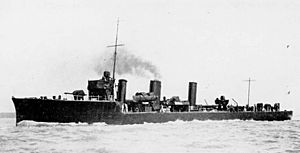HMS Fortune (1913) facts for kids

HMS Fortune in pre-war black paint, and without pennant number
|
|
Quick facts for kids History |
|
|---|---|
| Name | HMS Fortune |
| Builder | Fairfield Shipbuilding and Engineering Company, Govan |
| Yard number | 488 |
| Launched | 17 March 1913 |
| Fate | Sunk by SMS Westfalen at Battle of Jutland on 1 June 1916 |
| General characteristics | |
| Class and type | Acasta-class destroyer |
| Displacement | 1,072 t (1,055 long tons) |
| Length | 267 ft 6 in (81.53 m) |
| Beam | 27 ft (8.2 m) |
| Draught | 9 ft 6 in (2.90 m) |
| Installed power |
|
| Propulsion |
|
| Speed | 29 kn (54 km/h; 33 mph) |
| Complement | 73 |
| Armament |
|
HMS Fortune was a destroyer ship that served in the Royal Navy. She was part of the Acasta class of destroyers. The ship was built in 1913 and sadly sank during a famous naval battle called the Battle of Jutland in 1916.
Contents
What was the Acasta-class design?
The Acasta-class destroyers were bigger and had stronger weapons than earlier ships. They were about 25% heavier. These ships were the first to use a new type of 4-inch gun. These guns were placed on the front deck and on both sides of the ship.
All Acasta-class ships had three funnels. The one at the front was tall and thin. The second was short and wide, and the third was similar to the second but narrower. A special feature of this class was a torpedo tube placed between the second and third funnels.
There were twelve standard ships built to a common design. Eight other ships were "builders' specials," meaning they had slight differences. For example, some were shorter or had different engines. HMS Fortune was one of these special ships.
How big was HMS Fortune?
HMS Fortune weighed about 1,072 tons. She was about 267 feet 6 inches (81.5 meters) long. Her width, called the beam, was 27 feet (8.2 meters). The part of the ship under the water, known as the draught, was 9 feet 6 inches (2.9 meters) deep. The ship had a crew of 73 sailors.
What powered HMS Fortune?
The ship was powered by four special boilers that created steam. This steam then drove Parsons steam turbines, which are like powerful engines. These engines turned two shafts, allowing the ship to reach a top speed of 29 knots (about 33 miles per hour or 54 km/h). HMS Fortune also had a unique "clipper bow," which is a special shape at the front of the ship.
What weapons did HMS Fortune carry?
HMS Fortune was armed with three 4-inch guns. One of these guns was placed on a platform between two of the ship's funnels. She also had a smaller 2-pounder gun. For attacking other ships, Fortune carried two torpedo tubes. These tubes could launch 21-inch (533 mm) torpedoes, which are underwater missiles.
Construction and service of HMS Fortune
HMS Fortune was built by the Fairfield Shipbuilding and Engineering Company. Her construction began in 1911–1912, and she was officially launched on March 17, 1913. For a short time in October 1913, she was renamed HMS Kismet, but her original name, Fortune, was quickly given back.
After she was finished, Fortune joined the 4th Destroyer Flotilla. This group of ships served with the main British fleet, known as the Grand Fleet, when World War I began.
The Battle of Jutland and her sinking
On the evening of May 31, 1916, HMS Fortune was part of the 4th Flotilla. They were protecting the back of the Grand Fleet during the Battle of Jutland. This was a huge naval battle against the German High Seas Fleet.
Around 11:20 pm, the 4th Flotilla saw some unknown ships. Thinking they were British, the leader ship, Tipperary, sent a signal. But the ships were German battleships and cruisers. They turned on their lights and started firing. Most of their shots hit Tipperary, which quickly caught fire. The British destroyers fired back and launched torpedoes. This caused some confusion and a collision among the German ships.
During this intense fight, Fortune and Ardent got separated from their group. They went looking for the German ships that had pulled back. Around 11:30 pm, they found four large German ships and attacked them. Both Ardent and Fortune were sunk in the battle that followed. The last anyone saw of Fortune was her on fire but still firing her guns as she went down.
The place where HMS Fortune sank is now a special "protected place." This means it is protected under the Protection of Military Remains Act 1986.
Pennant numbers
| Pennant Number | From | To |
|---|---|---|
| H30 | 6 December 1914 | 31 May 1916 |

